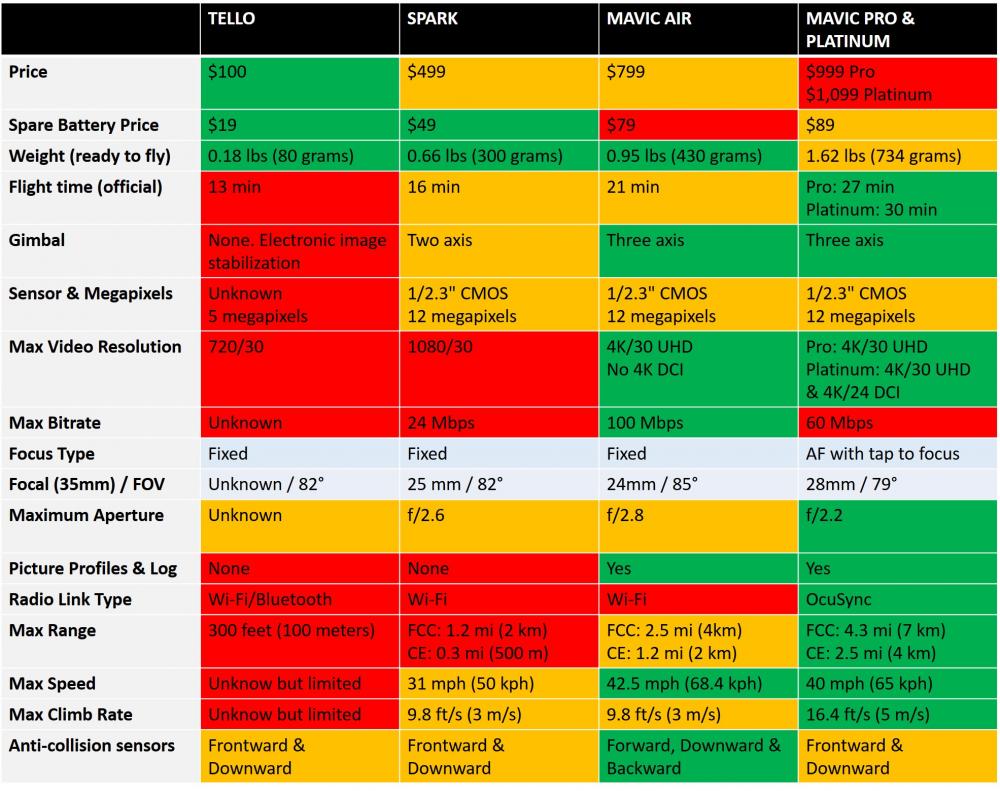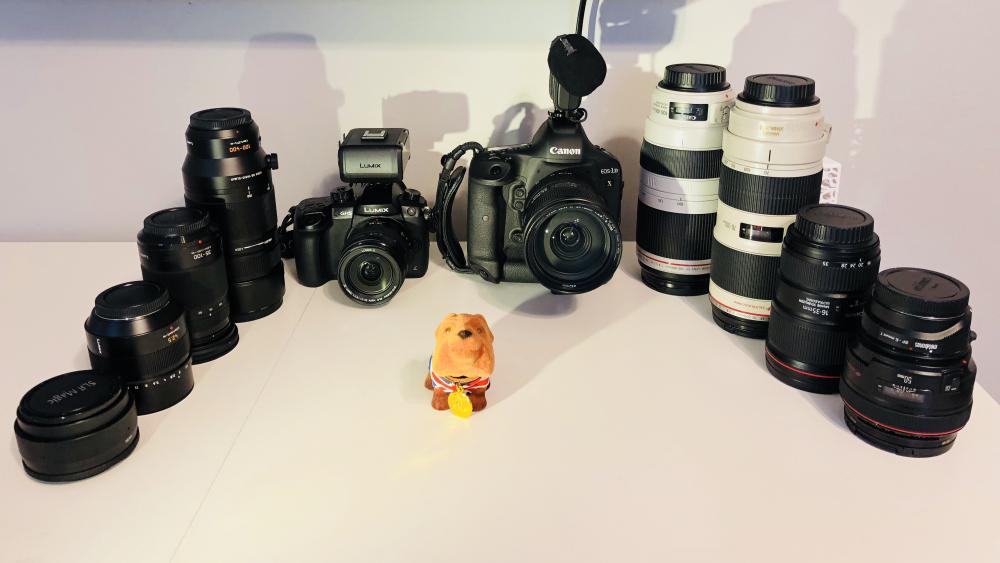Leaderboard
Popular Content
Showing content with the highest reputation on 01/28/2018 in all areas
-
I find all this 8 bit vs 10 bit talk a bit silly. 10 bit gives you only an incremental increase in grad-ability -- if your workflow requires heavy grading then RAW is where you need to be. And if you're not shooting RAW and you think you need 10 bit over 8 bit, I think you need to ask yourself why. 10 bit isn't going to help if you shoot in crappy light. 10 bit isn't going to help you rescue a shot 4 stops over. 10 bit isn't going to give you the malleability to create an interesting look from a badly lit scene. I know all this because I shoot mostly uncontrolled/run-and-gun and I've owned both a GH4 with VLog and a Shogun, and a BMMCC, and I can tell you that if the scene looks crap to your eyes there's no rescuing that even if you'd shot on an Alexa. And if you're good enough to grade beautiful cinematic scenes then you've got the know-how to fake it with a decently shot 8 bit file. None of this is to say that you should or shouldn't get a C200, because you need to take into account the way you shoot. I chose a C100mk2 because the package has everything I need to work solo, but I wouldn't chose that camera if I had the budget for crew. I chose to buy the cheapest camera that has everything built in so when I shoot I can concentrate on telling the story. I'd like to get a C200 when the prices come down because it would fit on a gimbal better, and the autofocus is better. I love Canon's DPAF system, it increases my hit rate and helps me shoot more efficiently. Canon Log is super easy to grade and work with as long as you protect your highlights -- half stop over and the highlights are cooked, but I've brought back shots that were 2+ stops under (because I forgot to change my ND setting, duh!) with barely an issue.3 points
-
2 points
-
C200 - some thoughts
Mattias Burling and one other reacted to mercer for a topic
There’s nothing to defend or ridicule. Canon released a camera that does A or B... if A or B doesn’t fit your needs, then buy a different camera. It’s really quite simple.2 points -
Is the EOS-M *THE* Digital Super-8 Camera?
kidzrevil reacted to Matt James Smith ? for a topic
I've been playing half-heartedly with ML on my EOS-M for a while but in general lost interest due to annoyances such as the focus pixels, low resolution and workflow. However, inspired by recently released footage from Kodak's new Super-8 camera and fond memories of playing with real Super-8 footage in art school, I decided to mess around with the EOS-M again to see how close I could get to the Super-8 aesthetic. Turns out I surprised myself! I've only shot a few early tests so far but the following video is, I think, very usable as a digital Super-8 stand-in. The basic specs are as follows: 4:3 ratio (like Super-8) 1440 x 1078 resolution (plenty for Super-8) 18fps (same as consumer Super-8) 12-bit Lossless RAW (continuous!) 5x zoom (haven't accurately calculated crop factor/sensor size in relation to Super-8 yet - would appreciate help with this) 3X3 Crop mode (Experimental build: magiclantern-crop_rec_4k.2017Dec19.EOSM202) Also- no focus pixels! (I have no idea why this is. They reappear if you go up to 14bit lossless or use any of the standard 10/12/14-bit modes). Below are two versions of my initial tests - the first is with FilmConvert film emulation applied, the second is without FilmConvert, just some basic contrast and saturation tweaks. Sorry the grade isn't very good I'm getting used to both the EOSM DNG's and FCPX's new grading tools. FilmConvert: https://vimeo.com/253014693/badd381eb4 No FilmConvert: https://vimeo.com/253014620 My post workflow is very simple: convert .MLV files to DNG's with MlRawViewer and then drop them straight into FCPX. Do a bit of colour correction with an adjustment layer if needed, then export clip as ProRes 4444 XQ. Bring it back into FCPX and conform the 18fps to the fps of the timeline (I always use a 25p timeline and *think* this requires slowing the 18fps clip to 72% but I'm not confident my maths are accurate - it certainly looks close to normal speed to me though). I'm not very technical so you won't find much explanation of why it's working from me. I'd appreciate contributions to what's going on here so I understand it better and other can replicate if they want to. In particular I'd like to figure out the effective sensor size I'm using, and also why there are no pink dots. The things that excite me about it as a viable Digital Super-8 camera are: 1. The shutter speed - only Magic Lantern allows that really, and it really helps give that authentic Super-8 feel. 2. The 12bit colour space and RAW grain makes the footage film-like and organic. 3. The fact you can adapt C-mount lenses to the EOS-M. The lens I used for these tests is just the 15-45mm EF-M kit lens in manual focus mode. However I have a Cosmicar 6mm f/1.2 on its way to me as we speak and if I can get it to infinity focus I think I'll have a 'normal' lens (again, I need to figure out the imaging area I'm working with). 4. Shooting 4:3 and 18fps, like Super-8, allows continuous shooting. Things I don't like: 1. Live view is not perfect but using the info button you can jump between Canon's 5x zoom to focus and ML's rather choppy live view for framing. 2. I'm not seeing horrible rolling shutter but it's no Digital Bolex so that does give it away as digital footage somewhat. I hope some others start playing around with these settings. With the 16mm Digital Bolex discontinued and Kodak's new Super-8 camera all the rage, there's a space for a small sensor digital cinema camera to get some love.1 point -
Hammarvägen 4 (GH5 cinematic short)
JordanWright reacted to Brother for a topic
Don't know how many Swedes are on this forum except for me and Mattias so the voice over won't mean much. Hopefully the images tell their own story. Shot on Panasonic GH5 and Olympus 25/1.2 with a Tiffen Black Pro Mist 1/4. Graded with Filmconvert.1 point -
Interesting article (NX lenses mentioning)
Pavel Mašek reacted to Kisaha for a topic
It is an interesting article about mirrorless cameras, and a confirmation of my view that one of the major strengths of the NX system were the -not so many, but most quite good- lenses. "Sony — NEX is history. But so, it appears, is the A5xxx. Really? The crop sensor Sony line is now a series of three cameras each of which is a "stick more sensor tech in it" version of the former? I fail to see how this is a useful strategy. Things that were wrong with the A6000 are still wrong with the A6500 (and A6300 in between). And when all is said and done these cameras seem a lot more GameBoy than anything else on the market. Don't get me wrong, I like them, but... Note to Sony executives: You're making the same mistake Nikon made with DX, and Canon made with EF-S and is making with EF-M. Samsung made lenses for their NEX-clone that clearly bettered what you put out. You can put all the tech you want at the sensor, but it's the optics out front that are hurting your image quality, not the sensor. What I'd give for Samsung's 16mm f/2.4, 20mm f/2.8, 30mm f/2, 45mm f/1.8, 60mm f/2.8, and 85mm f/1.4 in a Sony E-mount. And no, your Sony 16mm, 20mm, 30mm don't even come close." http://www.sansmirror.com/newsviews/the-latest-state-of-mirrorl.html unfortunately, even someone mentioning the NX system is news for us! It would be interesting if anyone could make a similar evaluation for the NX system in the end of 2017, almost 2018. I see the system being used from some of us until 2020 at least.1 point -
Fringer EF-Fuji X smart adaptor available
buggz reacted to Aussie Ash for a topic
https://www.fringeradapter.com/#for-x-mount1 point -

Time for a shootout?
Rinad Amir reacted to DBounce for a topic
I’m sort of kicking around the idea of doing a shoutout between the 1DXMK2 and the Panasonic LUMIX GH5. It’s been a while since I’ve used the Canon for video... mostly the GH5 has been my weapon of choice. But I was never disappointed with the video from the Canon. However, for grading the 10bit footage of the GH5 seems to be more flexible. What got me started on the shootout idea was a YouTuber who said he’s returning the Canon and keeping his 5DMk4. One of the reasons he states is ISO performance... something I have never had issue with on the 1DXMK2. I’ve managed with the limited ISO of the GH5, which The 1DXMk2 handily outperforms. So here’s the question... do the shootout now, or wait till I get me hot little paws on the GH5S? I’ll be using a MB SB to keep things even. What do you think. Or is this one already put to bed? And I’m not just speaking about low light. Oh, also... if any of you have a C200 and one of these two... or both... I would love to see how they all compare1 point -
True, and to be honest, nobody will notice ether, I have never seen someone watching a scene and notice if it was shoot in 8-bit or 10-bit, you can see the difference in your 4k OLED TV putting both files next to each other, but thats all, I agree with @mercer and @jhnkng, if you are shooting with Canon 8-bit and screw up during the shooting and you are not able to push the footage enough to save the take, there is no way 10-bit is going to do it for you, but RAW, yes RAW could do it, so the C200 is perfect imo, 4k 8-bit for 90% of docs, and 4k RAW for movies and 10% of docs where the light is just crap....1 point
-
C200 - some thoughts
webrunner5 reacted to ade towell for a topic
As always it seems everyone has different needs in a camera. There is quite a difference when grading 10 bit log compared with 8 bit, and with the C200 you are giving up dynamic range sticking to their 8 bit codec. For me the fs7 seems to have spoilt many of the production companies at least in my world, and so they are now asking more for 10 bit not 8 bit. You can argue they should instead just leap to dealing with RAW but that is not where they seem to be at, for better or worse... There is a lot to like about the c200 and even though I do prefer the EVA1's image, the c200 ticks most of the boxes for me, I come from the c100 so it would seem like a natural step - but for that pesky 8 bit (or RAW). Canon are trying to push me towards the C300 mk2 but that's another jump in price (and has its own niggles for me) - am swinging towards the EVA1 with GH5 or GH5s as b cam, a lot to be said for having cameras that can easily be graded to match1 point -

Treasures from the Wreck of the Unbelievable
Jonesy Jones reacted to kaylee for a topic
OOOoooooo i kno what this issssss i cant wait to see it but i dont have netflix yeah, TOTALLY do what Jonesy said, IF YOU DONT KNOW WHAT THIS IS JUST WATCH IT. DONT GOOGLE IT1 point -

Say Your Goodbyes to SDR!
jonpais reacted to webrunner5 for a topic
Speaking of HDR I guess I have to Apologize to Jon and anyone else that has contributed to it. I never have looked at it because I had no way to Look at it, I thought. Well someone on here mentioned it works on a Note 8, and since I just happen to have a Note 8 I looked it up. And the more I look at it the more I want to do it LoL. Damn it, more money. I guess I am hooked. Thanks, I guess. This is a HDR Photo I took tonight with my Samsung Note 8. Hands down the most colorful, sharpest photo from it Ever. I think pretty good for a first effort. I think, may be wrong, that is some serious DR from a Cell Phone.1 point -

C200 - some thoughts
webrunner5 reacted to DBounce for a topic
Are there any cinema cameras that have IBIS? Nothing comes to mind1 point -
Say Your Goodbyes to SDR!
webrunner5 reacted to markr041 for a topic
This was my first attempt (successful) to make a 4K HDR test video back in November 2016, using the GH4 (which outputs 10bit 422) and the Shogun Inferno. The difference between the SDR and HDR versions is immense - the HDR version just glows, the SDR version looks ordinary: You need to go to the YouTube app (by clicking the video title) to play in HDR, it will not play in the window.1 point -
C200 - some thoughts
webrunner5 reacted to Kisaha for a topic
BBC it is not just a TV station in UK, the number 1 cable TV station here gave us a few pages of standard, and they were the BBC ones. They even asked for surround sound (which didn't happen in the end because of budget restrictions) but in the end we went with the C300mkII. Specs are not just numbers in pro numbers, organizations and TV stations can ask for whatever they want, if you do not provide, you can rent of course. It is no secret the C100mkII is my most used camera (more than my NX cameras) but in some cases we had to use the JVC LS300 because we had to deliver a more robust codec. The truth is that I paused when I learned about the non existed middle codec.1 point -
The light is the same, but the intensity (concentration) is different. You do not see any difference in DOF. Think of it this way, normal sunlight will not catch a newspaper on fire, but concentrate it with a magnifying glass and that same normal sunlight will cause the paper to burn. For the camera sensor it is getting more light than it normally would, because the concentration is higher. End result is you can work at lower ISOs, but you gain no DOF advantage. This is not theory... I see this whenever I use my SpeedBoosters.1 point
-
Say Your Goodbyes to SDR!
kidzrevil reacted to Mattias Burling for a topic
Since 4K still isn't even close to be more spread than 1080p, let alone 720p. I too think it will be a few years before its any sort of standard. 5 years if Im very, very, veeery generous.1 point -
I’ve kinda lost my faith in pseudo log profiles. Real logs are not merely color profiles. There are no real log profiles for the 1DXMK2. And I can tell you from my previous experience and grading 1DXMK2 footage vs 10bit VLog that the Canon footage breaks much sooner than VLog. For that reason I tend to pick a color profile and bake it in on the Canon. But IQ is a closer call between these two. It’s been awhile since I shot video with the Canon, so I’m also focusing on the shooting experience between the two after owning both for some time. The stills performance of the 1DXMK2 is so good it make even the ham-fisted look like a pro. The GH5 makes you work harder to get magic. I’m pulling out the tripod1 point
-

Sony A7R3 users - THROW AWAY YOUR CANON LENSES!
Don Kotlos reacted to IronFilm for a topic
I've noticed this a few times from people, that although DPAF is great it can sometimes be noisy. Which would annoy the hell out of me as a sound recordist if I came across this. haha, yeah "noiseless" is totally different for photographers than video folk!! A small bit of noise is ok for a stills guy shooting in a church for a wedding, but would drive me nuts.1 point -
1 point
-
I've certainly seen some nice shots on a hacked GH2. Having never owned one, one always needs to imagine how good it looks without the compression. It's funny because the GH5S is bringing back the multi-aspect sensor- something the GH2 already had and we lost with the GH3, GH4, and GH5. To my eyes, the GX80 has a slightly different color algorithm than the GH4 and I'm satisfied. The GX80's size, colors, 4k, and IBIS trumps the hacked GH2's 1080p, but right now the GH2 is half the cost- not bad. Personally, the GX80's still a value option that's hard-to-beat. It gets the job done for me. I still haven't seen any features in any of those new Panasonic cameras that would merit the price jump. Secondly, the GX80's successor is going to have to be pretty damn good to convert me.1 point
-
@kidzrevil Thanks! Even though i liked the Pro Mist on my Olympus 25 i think the Sigma and Pro Mist made a better match. It's funny how one looks for extreme sharpness in some lenses and it others not at all, i'm thrilled over that the Sigma and Speedbooster doesn't deliver 100% in that aspect!1 point
-
I have both. 5DMK3 Raw is very stable with the right cards. I cannot go back to 8bit for anything except long form events. The RAW work flow is really not a hassle and it's much like the workflow for handling RAW images. DNG creation is easy with the 5D raw files and from there its the same experience as editing blackmagic DNG files in Davinchi Resolve. If your looking for a raw camera for only video then I would recommend the Blackmagic Pocket ONLY if you purchase a speed booster to go along with it. With the speed booster you will be able to shoot on par with a 5DMK3 in low light situations. The only weaknesses of the Blackmagic pocket is the chance of moire, poor battery life, horrible audio preamps(only remedied by using a videomic pro with +25 db set). 5D raw weaknesses, poor in camera playback and much shorter record times while using raw. Below is some 5D Raw footage I shot at 2 weddings in 2015 scaled up to 4K.1 point
-

C200 - some thoughts
webrunner5 reacted to andrgl for a topic
Canon forces you to shoot 60 fps in 10bit RAW. (Found this out the hard way on a shoot.) Think about that. They fucking have an intermediary 10bit codec right there ready to go, but say fuck you, deal with 125 MB/s. (BTW: 24 fps 10bit on the C200 would theoretically top out at 50MB/s, which is half the size of 422 ProRes HQ.) Anyone who can defend Canon for pulling shit like this, do they pay you? Or do you just not shoot with these cameras to really understand how flawed they are?-1 points





